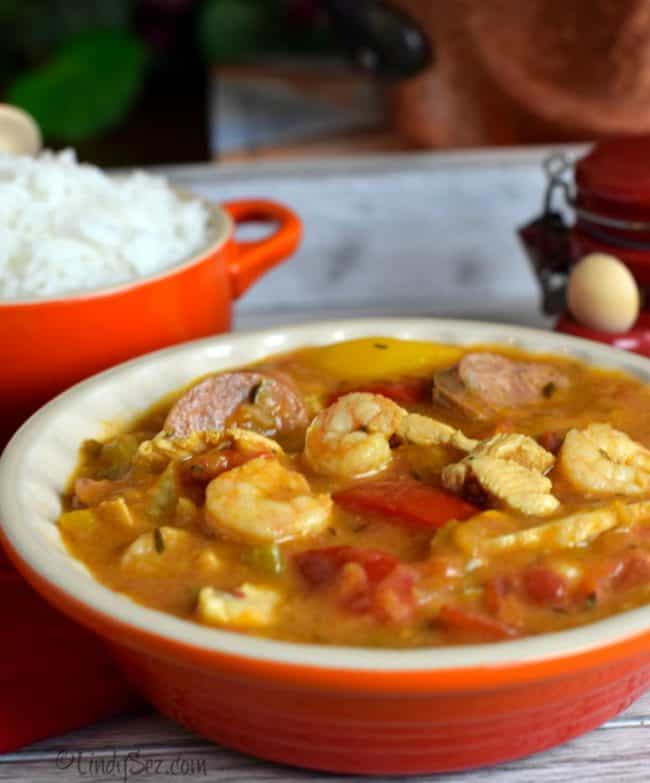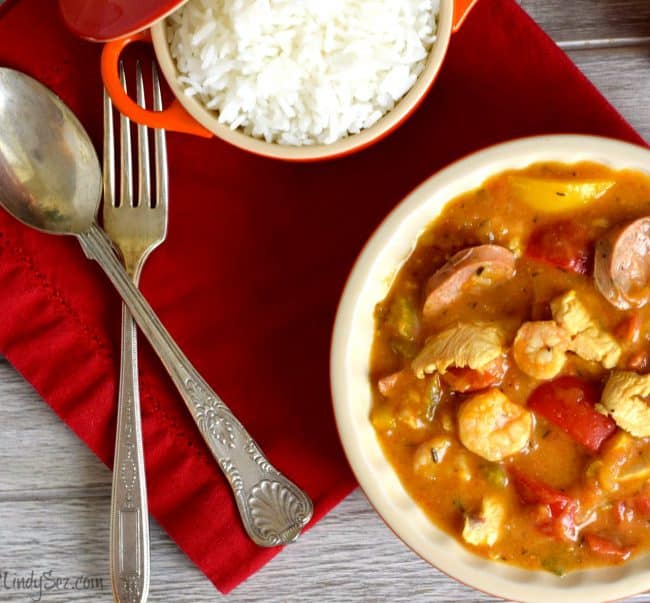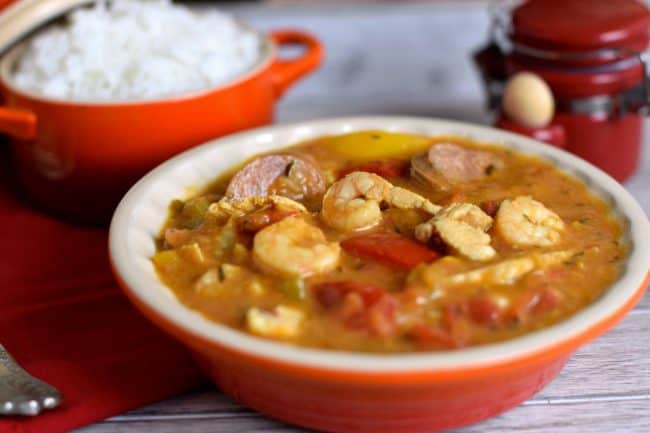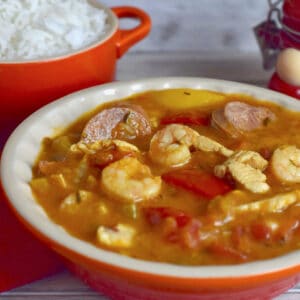"Gumbolaya", a mix of Gumbo and Jambalaya, creates a stunning seafood chowder that's easy to make, low-cal, and delicious. Serve with plain steamed rice or try it with some Twice Cooked Brown Rice.

How to make Gumbolaya - New Orlean's Cajun Stew
I wanted to make a seafood stew...dishy thing.
I thought of Gumbo and I thought of Jambalaya and both sounded like right up the alley of my thoughts.
So I did some investigation.
If you know me, you know I like to bring maximum flavor to the table, but I want to make it easy to get on the table.
I also want to get it on the table in a timely manner.
That timely manner is generally within an hour or less, in this case, it's the less.
"Dinner on the table in about 30 minutes."
But as I investigated both Gumbo and Jambalaya recipes, I found, they are really very similar.

What's the difference between Gumbo and Jambalaya?
One of the things I love about cooking and developing recipes is finding out about them.
Both of these recipes originate in Louisiana. Jambalaya is mostly influenced by Spanish and French cultures.
Gumbo is influenced by many cultures, including Spanish and French, but also German, West Africa, and Choctaw Indians.
Both use the basic "Creole" trinity of onions, celery, and bell pepper, and both use the same meats, smoked sausage, chicken, and shrimp.
So what are the actual differences?
- Gumbo uses a dark roux to start - Jambalaya does not.
- Gumbo is served with rice on the side - Jambalaya is made with rice in the dish.
- Gumbo uses a fish or clam stock - Jambalaya does not.
- Gumbo contains okra and filé powder - Jambalaya does not.
Basically, that's it.
That's all that is different between the two dishes - well, except perhaps that Gumbo is the "Official" dish of the State of Louisiana.
Taking the samenesses and differences into account, I decided to call my dish Gumbolaya because:
- I don't like Okra and didn't add it.
- I didn't have filé powder so didn't use that.
- I wanted to start with the rich dark roux that makes Gumbo so delicious.

What is Roux?
A roux is simply combining equal amounts of fat and flour and cooking it until it's thickened and brown.
The depth of the brown depends on the dish and for Gumbo you want it to be very deep in color - almost red-brown.
Tips on how to make a perfect roux
This is how to make a perfect roux for gumbo or in this case Gumbolaya.
- Heat a heavy deep pan over medium-high heat.
- Add the oil, remember the amount of flour will be equal to the amount of oil.
- Once the pan and the oil is hot, stir in the flour .
- Stir, constantly, until it begins to go dark.
- Turn the heat down slightly, to medium-low.
- Keep cooking and browning, until you reach a deep brownish-red color.
If you burn the roux, toss it out and begin again.
Making a good dark roux might take 5 - 10 minutes. Don't rush it.
Once you've got the roux right, add the "holy trinity" sautée until soft, then the rest is pretty, binga banga boom.
What is the Holy Trinity?
The Holy Trinity used in Cajun and Louisiana creole cooking is a combination of chopped onion, bell pepper (usually green), and celery in equal amounts.
I prefer red bell to green, but usually use a combination of both.

The Meaty Part
You can use either white meat or dark meat chicken.
Dark meat is more traditional, but I found sliced boneless skinless chicken breast worked great, cooked up quickly, and provided the flavor I wanted.
If you prefer to use dark meat, use cut-up boneless skinless chicken thigh, simmer the meat in the sauce for 10 minutes longer than the breast.
The sausage must be a smoked sausage.
While Andouille sausage is used most often, you can use kielbasa.
I used turkey kielbasa in my preparation. It provided the same meatiness, smokiness, and texture, but with much less fat and calories.
Shrimps may be large or small.
Shelled and deveined, tails off.
I happened to have some rather small shrimps, (70/90 count per pound) since these were the only size I could find that were wild-caught, and not from China or Vietnam where they are known to "inject" saline into the shrimp to up their per pound weight.
Do NOT buy those shrimp!
The small shrimps actually worked excellently in the dish as they were already "bite-size" and cooked quickly.
If you use a larger shrimp, cut it into bite-sized pieces.
So that is how I came up with my recipe for Gumbolaya. A perfect blend of two great classic Creole dishes - that are just so close - and yet...

Gumbolaya
Gumbolaya and Cornbread? Yes, please.
FAQ
You can use any shrimp you like but I always recommend that you choose shrimp that are wild-caught. DO NOT buy shrimp from Indonesia, China, Thailand, or Vietnam as these are known to be raised in dirty shrimp farms and/or may be injected with saline to boost their weight.
Not really. Smaller shrimp 51/60 and medium shrimp 41/50 can be left whole after removing the shell, tail, and digestive tract (that dark vein you can see down the back). Larger shrimp, 31/35 and 26/30 should be cut in half for east of eating.
While Andouille sausage is traditionally used, I often substitute Kelibassa, either pork or turkey, in its place. Taking into consideration Gumbolaya's international influences, you could also use a dried cured Spanish chorizo (not Mexican) or Portuguese Linguica.
More traditional is dark meat; use a boneless skinless chicken thigh cut into bite-sized pieces.
I have had a great deal of success using chicken breast also cut into bite-sized pieces.
If using thigh meat, simmer it in the sauce for about 10 minutes before you add the sausage and shrimp.
After your chicken is cooked, add the sausage to heat through. THEN add the shrimp and simmer gently until they just turn pink about 3 minutes total. Turn off the heat and serve.
I would stick to the original, but sometimes I use a combination of red and green peppers. You can use red onion in place of the Spanish yellow onion. Celery is celery. There is no substitute.
Need more inspiration? Try one of these "spicy" seafood dishes...
Shrimp with Fresh Fra Diavlo Sauce
Snapper with Shrimp Creole Sauce
Beer-Braised Mussels with Andouille Sausage

Gumbolaya
Ingredients
- ¼ cup neutral oil I like grapeseed
- ¼ cup flour
- 1 cup diced onion
- 1 cup diced bell pepper I used red and yellow
- 2 large stalks celery diced (about ¾ to 1 cup)
- 2 teaspoons minced garlic about 4 large cloves
- ¼ cup dry white wine or white vermouth
- 1 15-ounce can diced tomatoes with juice (lightly chopped)
- ¾ cup fish stock or clam juice
- ¾ cup low-salt or homemade chicken broth
- 1 teaspoon dried thyme
- ½ teaspoon dried oregano
- 1 bay leaf torn
- ¼ teaspoon cayenne pepper
- Dash or three Louisiana Hot Pepper Sauce or Tabasco®
- Salt and pepper to taste
- 8 ounces diced chicken dark or white meat
- 6 ounces sliced Andouille sausage or sub Turkey kielbasa
- 8 ounces shrimp shelled and deveined
- Cooked rice for serving
Instructions
- In a heavy saucepan, heat the oil over medium heat until very hot, add the flour and, while stirring constantly, cook until the mixture is reddish-brown, about 5 minutes. Add the onion, peppers, and celery, and cook until the soft and tender, stirring occasional - about 10 minutes. Add the garlic along with the wine. Stir until thick, then add the tomatoes, with juice, fish stock or clam juice, broth, thyme, oregano, bay leaf, cayenne, and hot sauce. Simmer for 10 minutes.
- Stir in the chicken and cook until the chicken is done, add the sausage and shrimp and simmer about 5 minutes, or until the shrimp are pink and cooked. Taste and adjust seasonings. Serve with rice.

Leave a Reply